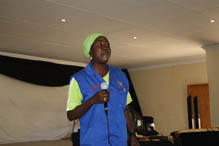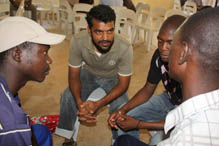
Community members discuss what animals they associate with during the ice breaker session
March, 4 2010 – A fight over a girl leads to one man being stabbed to death and the perpetrators hiding, because they anticipate the community’s response to the killing. Proving their fears, the community hunts them down, finding them as they’re about to hand themselves over at the police station, where they’ve fled to find refuge.
Despite the close proximity to the police station, the angry mob drags them off to a spot to face their fate; the mother of one of the perpetrators is dragged along to watch her son being stoned to death, for killing someone else’s son.
These were the memories that hung over the community of Kamaqhekeza in Mpumalanga, on the eve of the community conversation convened by the Nelson Mandela Foundation to promote social cohesion. But despite these events, the community was not deterred from attending the conversation.
This was the final conversation in the area and it was aimed at consolidating the action plan developed previously, creating a vision that bolsters this, and hand over sustainability issues. There were about 90 people, made up of the community structures, including councillors, home-based care workers, and youth structures.
The facilitating team, consisting of Ken Mutuma, Nelson Mandela Foundation implementing partner, Pretty Mnisi, Martha Mashaba and Magan Dahir, started the session with an icebreaker. Split into groups, the members discussed their favourite animals and why they liked them.
The groups chose various animals, from the chicken because of its time-keeping characteristics; to the cat, which cleans itself; the black mamba, a shy and rare animal that avoids conflict; and the dog, man’s best friend, and reliable protector of the family.
The aim of the exercise was to take lessons from the animal kingdom, realising we all associate certain characteristics with certain animals. It is something we all have in common.
After the introductions, Mashaba reported on a previous conversation and explained that, “it was an introduction and a way of knowing one another as South Africans and non-South Africans”.
“We identified our concerns and reflected on the past 10 years and what good or bad happened that affected us.”
Mashaba added: “today is a building stone because previously, we discussed the fighting stone”.
The next activity, also done in groups and using the Community Capacity Enhancement (CCE) methodology envisioning tool, to help the community construct a vision, involved the participants discussing the dreams they have for their countries and where they would like to see their countries in the future.
Dahir explained that everyone has problems, “they are a part of our lives”, he said. “For every problem we have a solution,” Dahir said.
The aim of the exercise is to make the community aware that solutions start as dreams and then those dreams are turned into reality.
The groups were in unison mostly, as they all wanted an Africa without borders, where labels were done away with; they wanted all people to be just Africans. Songs and poems accompanied the dreams, one being:
“Lelilizwe ngelethu sonke, asisoze saphel’amandla,” meaning “this land is ours, we will never lose power”.
Some of the community’s wishes included:
• A poverty-free South Africa
• An orphan-free South Africa, where my child is your child
• A crime-free South Africa
• Africa with no informal settlements
• Homes for the elderly
• Equality in the eyes of the law
• Africa with clean governance
• Africa with hard-working individuals who don’t expect the government to do things for them
• Quality health care
• A loving and caring continent
• A spirit of togetherness
• No discrimination
• Respect for each other’s religions
• Sharing of skills among South African citizens and migrants
• Renovated public facilities
• No victimisation of women and children
The conversation concluded with the formation of a committee, to work with the facilitators and the community, to realise Kamaqhekeza’s dreams as soon as possible.
After the dialogues, we gathered a few reflections from participants:
“I am happy that the Nelson Mandela Foundation (NMF) organised this. I have gained a lot from this meeting. I met different people from different structures in the community. I hope that after the NMF has left, the conversation continues because there is a lot of fighting between us and the migrants from Mozambique and Swaziland. We need to invite more people so that they can also gain the knowledge we gained today and be empowered.” – Mabel Khoza- Shongwe, ward councillor
“It was a fabulous day and an eye-opener for us migrants and refugees staying in Mpumalanga. It’s our belief that the community will unite in fighting corruption, criminality and other injustices.” – Raphael Hlanga, Zimbabwean refugee community leader
“This is a great event; it unites us and makes us open towards each other. It takes away xenophobia and encourages us to treat each other as brothers and sisters. This event is important because we get to share the vision of Nelson Mandela. Through this people in this community get to know each other and learn about each other’s cultures and languages.” – Collen Magagula, chairman, African National Congress Youth League
“This dialogue is really important. It seeks to bring together the people of Africa. In this community we have people from other countries, such as Swaziland, Mozambique, Somalia, Pakistan, etc. Through this we will seek means of staying together and building each other up.
The youth of South Africa needs to wake up and realise that they can’t blame apartheid for everything even though it impacted badly on their lives. We have to be people that work hard be determined and seize the opportunities provided by the government. The youth needs to get educated, read more papers, listen to the news and be informed.” – Gcina Maseko, Department of Public Works, Roads and Transport
“Today was extremely great. I appreciate what the Nelson Mandela Foundation is doing in my community. What makes me happier is the participation; I didn’t expect so many people to come.” – Bongani Mashoka, musician from the community
“It was interesting because people talked without fear, and we talked about problems foreigners were facing and got to know of problems South Africans were facing too.
The conclusion was that we agreed to have another workshop to focus on how to solve those problems. Today everybody who came forward had a solution to solve a problem and the suggestions were frank. I will take forward what we discuss here to my community and make sure we apply the spirit of ubuntu.” – Ali Noor, Somali national and community leader
“I would say this is good; it gives people a platform to share ideas and helps them try and visualise what they’d like to have and see as a community.” – Busisiwe Ngomane, early childhood development practitioner at a local school
“Today was amazing; we far exceeded our expectations. Leaders of structures in the community attended the conversation. We inspired them to dream, have a vision and talk about that dream.
We shifted paradigms and inspired the community to achieve the unachievable. There is a lot of buy-in from the leaders that have come here today. We believe that the dreams we spoke about today will not be chucked out, but will be crafted and realised.
Through this conversation we want the community to own this venture. Through the action committees started here today we hope that dialogue in this community will grow so that when we come back 10 years from now, the community has changed.” – Ken Mutuma, Nelson Mandela Foundation implementing partner
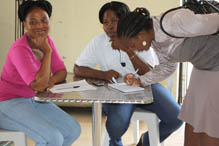
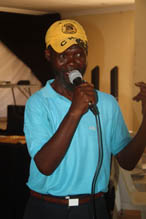
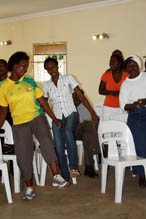
.jpg)
.jpg)
